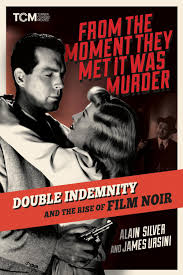
By: Jenny Castro
Los Angeles, CA (The Hollywood Times) 6/28/24 – Double Indemnity, the riveting 1944 film starring Barbara Stanwyck, Fred MacMurray, and Edward G. Robinson has long stood the test of time and is one of the most beloved and revered film noirs to ever grace the silver screen. Authors Alain Silver and James Ursini offer a fascinating inside look into the making of the film along with the events and people which inspired it. Their new book titled, “From The Moment They Met It was Murder, Double Indemnity And The Rise of Film Noir,” was released earlier this Spring in partnership with Turner Classic Movies in celebration of the film’s 80th anniversary. The book starts off with a behind the scenes look at the true crime story of Ruth Brown Snyder who along with her lover Judd Gray took part in murdering Ruth’s husband Albert Snyder. The horrific crime took place in New York City in 1927 and led to tabloid exploits by local newspapers such as New York’s Daily News which depicted Ruth Brown Snyder in an electric chair. Subsequently, the crime was the inspiration behind “Double Indemnity,” the novel turned film in which Stanwyck portrays femme fatale (Phyllis Dietrichson), MacMurray as the gullible insurance agent (Walter Neff), and Robinson as the claims manager.
 Authors Silver and Ursini engage readers with detailed narratives regarding the Snyder murder and the impact it had on journalism, Broadway, and eventually film. The first few chapters are dedicated to showcasing the significance of the case and the interest it gained from journalist turned author James Cain who previously covered the trial while working for The Daily News in New York. Cain became the catalyst for further interest in the case as he wrote a serial (sequential installments) and eventually a full novel covering the tragedy. Cain also pegged other novels which turned into film classics including “Mildred Pierce,” and “The Postman Always Rings Twice.” The authors then dedicate a chapter each to both Screenwriter Raymond Chandler (The Mystery Writer) and Director Billy Wilder (The Austrian Journalist) diving into their backgrounds, personalities, and rise from obscurity to prominence in Hollywood.
Authors Silver and Ursini engage readers with detailed narratives regarding the Snyder murder and the impact it had on journalism, Broadway, and eventually film. The first few chapters are dedicated to showcasing the significance of the case and the interest it gained from journalist turned author James Cain who previously covered the trial while working for The Daily News in New York. Cain became the catalyst for further interest in the case as he wrote a serial (sequential installments) and eventually a full novel covering the tragedy. Cain also pegged other novels which turned into film classics including “Mildred Pierce,” and “The Postman Always Rings Twice.” The authors then dedicate a chapter each to both Screenwriter Raymond Chandler (The Mystery Writer) and Director Billy Wilder (The Austrian Journalist) diving into their backgrounds, personalities, and rise from obscurity to prominence in Hollywood.
When it pertains to the film itself, the latter of the book provides information on the casting, locations, reshoots, and disagreements that embodied the screenwriting and film production process. Film noir fanatics will be delighted by the candid photos provided and by reading on the fascinating backdrops regarding the making of the film including the disregarded ending, wardrobe and costumes, reluctance from the lead actors, change of dialogue, billing, pay, working relationships, and comparisons to both Cain’s novel and the real-life Synder case. In Chapter 7 titled, “Aftermath and Movement: The Rise of Film Noir,” the authors touch upon the success of the film and the negative and positive reviews received from critics. It’s also telling of the film’s impact on the noir genre and how many copy-cat productions were soon in play after the release along with the rise of noir popularity in Hollywood itself. Receiving 7 Oscar nominations, “Double Indemnity,” defined an era of noir which has captivated audiences for decades. An overall deep dive into the origins of this iconic cinematic masterpiece, the book is perfect for any noir or film history buff looking to deepen their knowledge on Hollywood history and true crime.
Available to purchase on Amazon or Running Press | Hachette Book Group.